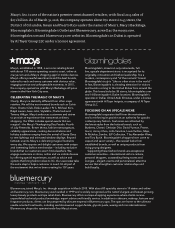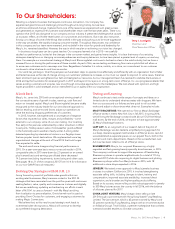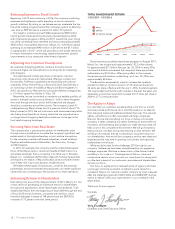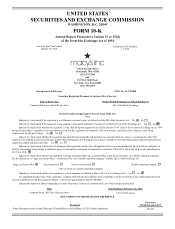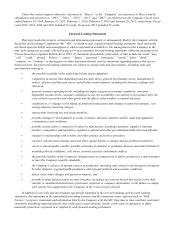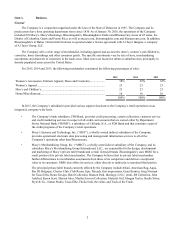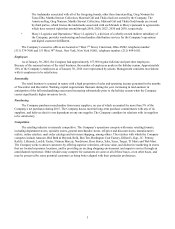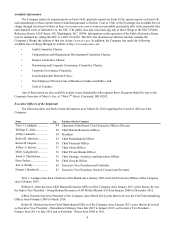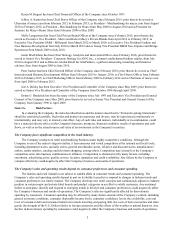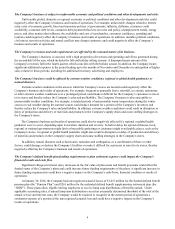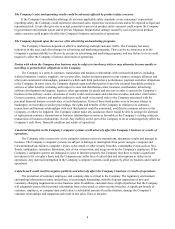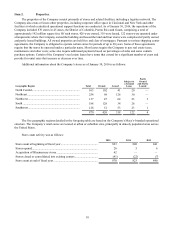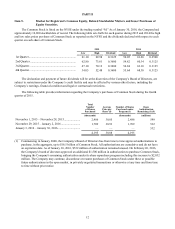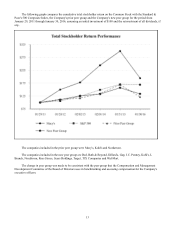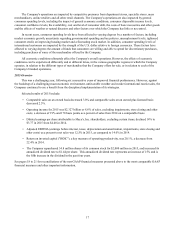Macy's 2015 Annual Report Download - page 12
Download and view the complete annual report
Please find page 12 of the 2015 Macy's annual report below. You can navigate through the pages in the report by either clicking on the pages listed below, or by using the keyword search tool below to find specific information within the annual report.7
Increases in the cost of employee benefits could impact the Company’s financial results and cash flow.
The Company’s expenses relating to employee health benefits are significant. Unfavorable changes in the cost of
such benefits could negatively affect the Company’s financial results and cash flow. Healthcare costs have risen
significantly in recent years, and recent legislative and private sector initiatives regarding healthcare reform have resulted
and could continue to result in significant changes to the U.S. healthcare system. Due to the breadth and complexity of the
healthcare reform legislation, the lack of implementing regulations and interpretive guidance and the phased-in nature of
the implementation of the legislation, the Company is not able at this time to fully determine the impact that healthcare
reform will have on the Company-sponsored medical plans.
Inability to access capital markets could adversely affect the Company’s business or financial condition.
Changes in the credit and capital markets, including market disruptions, limited liquidity and interest rate
fluctuations, may increase the cost of financing or restrict the Company’s access to this potential source of future liquidity.
A decrease in the ratings that rating agencies assign to the Company’s short and long-term debt may negatively impact the
Company’s access to the debt capital markets and increase the Company’s cost of borrowing. In addition, the Company’s
bank credit agreements require the Company to maintain specified interest coverage and leverage ratios. The Company’s
ability to comply with the ratios may be affected by events beyond its control, including prevailing economic, financial and
industry conditions. If the Company’s results of operations or operating ratios deteriorate to a point where the Company is
not in compliance with its debt covenants, and the Company is unable to obtain a waiver, much of the Company’s debt
would be in default and could become due and payable immediately. The Company’s assets may not be sufficient to repay
in full this indebtedness, resulting in a need for an alternate source of funding. The Company cannot make any assurances
that it would be able to obtain such an alternate source of funding on satisfactory terms, if at all, and its inability to do so
could cause the holders of its securities to experience a partial or total loss of their investments in the Company.
The Company depends on its ability to attract and retain quality employees.
The Company’s business is dependent upon attracting and retaining quality employees. The Company has a large
number of employees, many of whom are in entry level or part-time positions with historically high rates of turnover. The
Company’s ability to meet its labor needs while controlling the costs associated with hiring and training new employees is
subject to external factors such as unemployment levels, prevailing wage rates, minimum wage legislation and changing
demographics. In addition, as a large and complex enterprise operating in a highly competitive and challenging business
environment, the Company is highly dependent upon management personnel to develop and effectively execute successful
business strategies and tactics. Any circumstances that adversely impact the Company’s ability to attract, train, develop
and retain quality employees throughout the organization could negatively affect the Company’s business and results of
operations.
The Company depends upon designers, vendors and other sources of merchandise, goods and services. The Company's
business could be affected by disruptions in, or other legal, regulatory, political or economic issues associated with, our
supply network.
The Company’s relationships with established and emerging designers have been a significant contributor to the
Company’s past success. The Company’s ability to find qualified vendors and access products in a timely and efficient
manner is often challenging, particularly with respect to goods sourced outside the United States. The Company’s
procurement of goods and services from outside the United States is subject to risks associated with political or financial
instability, trade restrictions, tariffs, currency exchange rates, transport capacity and costs and other factors relating to
foreign trade, including costs and uncertainties associated with efforts to identify and disclose sources of "conflict
minerals" used in products that the Company causes to be manufactured and potential sell-through difficulties and
reputational damage that may be associated with the inability of the Company to determine that such products are "DRC
conflict-free." In addition, the Company’s procurement of all its goods and services is subject to the effects of price
increases which the Company may or may not be able to pass through to its customers. All of these factors may affect the
Company’s ability to access suitable merchandise on acceptable terms, are beyond the Company’s control and could
negatively affect the Company’s business and results of operations.


